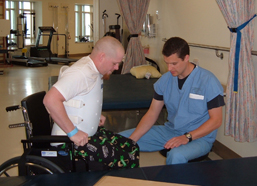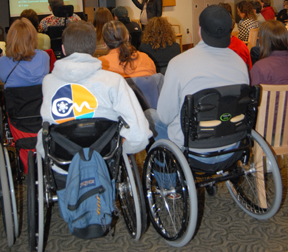2014 Spinal Cord Injury Wellness Summit
The Use of Medical Marijuana to Manage Symptom Burden in Spinal Cord Injury
By Gregory T. Carter, MD, MS
Medical Director, St. Luke's Rehabilitation Institute, Spokane, Washington, and faculty, University of Washington Medical School
The national conversation about cannabis (marijuana) is changing rapidly, and many people with SCI would like to know more about its use as a medical treatment for pain and other symptoms. In this forum presentation, Dr. Carter discusses the history of medical cannabis in the U.S., the physiological effects of cannabis, and the current scientific evidence regarding the safety and effectiveness of cannabis as a treatment for neuropathic pain when used under a physician's supervision. Watch the video or read the report, below.
Download the presentation slides (PDF)
Presentation time: 54 minutes. After watching, please complete our two-minute survey!
You can also watch this video on YouTube with or without closed-captioning. For a complete list of our SCI Forum videos, go to http://sci.washington.edu/info/forums/forum_videos.asp.
Report
Contents
- Introduction
- What is Marijuana (Cannabis)?
- History and Background
- How Does It Work?
- Medical vs. Recreational Cannabis
- Research
- Benefits of Medical Cannabis
- Using Medical Marijuana
- A Word of Caution
- Take-Home Message
- Resources
- References
Introduction
Marijuana (cannabis) is much in the news today. Medical marijuana, although still illegal under federal law, has been legal in several states for some time, and state laws about recreational marijuana are changing. As marijuana becomes more available, people interested in medical marijuana want information about what it is, what it’s good for, and how to use it.
What is Marijuana (Cannabis)?
Marijuana refers to the dried leaves, flowers, stems and seeds from the hemp plant Cannabis sativa, which contains numerous active chemical compounds called cannabinoids. Delta-9-tetrahydrocannabinol (THC) is the primary psychoactive ingredient in cannabis that acts on the brain and changes mood or consciousness. Other chemical compounds in cannabis that have biologic activity include cannabinol (CBN), cannabidiol (CBD), and cannabichromene. CBD, in particular, is thought to have significant analgesic (pain-relieving) and anti-inflammatory activity without the psychoactive effect (high) of THC.
History and Background
Cannabis has been used for medicinal purposes for thousands of years. It was first brought into western medicine in the 1840s by an English surgeon who learned about it in his travels through the Middle East.
For several decades cannabis was regularly prescribed by physicians in the U.S. and dispensed at pharmacies as a tincture or tonic for “nerve pain.” Beginning in 1937 the federal government started taxing and restricting its use, in spite of objections by the American Medical Association. In 1951 cannabis was classified as a narcotic, and finally in 1970 it was classified as a schedule 1 drug (like heroin and LSD), meaning it is considered dangerous and without accepted medicinal use. It has remained in this classification despite favorable findings from various government-appointed commissions on cannabis over the years: Nixon-appointed Shafer Commission in 1972; U.S. Institute of Medicine in 1982; and the U.S. National Institutes of Health Workshop on Medical Marijuana in 1997. Furthermore, the National Academy of Sciences and the American College of Physicians have all issued cautiously positive statements about cannabis.
“I’m here to say on the record that the classification as a schedule 1 drug doesn’t make any sense scientifically,” Carter said.
How Does it Work?
“We now understand a great deal about how cannabis works in the body,” Carter said. The cannabinoids activate specific receptors found throughout the body to produce pharmacologic effects, particularly in the central nervous system and the immune system. Pain is reduced when cannabis receptors are activated in the nervous system pathways that regulate pain perception.
When it is smoked, cannabis compounds pass rapidly from the lungs to the bloodstream, which carries the chemical to the brain and other organs. Vaporized cannabis produces the same effects without the smoke. It is absorbed more slowly when ingested in food or drink. The highest density of cannabinoid receptors is found in parts of the brain that influence pleasure, memory, thinking, concentration, sensory and time perception, and coordinated movement.
“I first stumbled onto medical cannabis 20 years ago when an ALS patient told me she was using it for pain and spasticity,” Carter recalled. “When medical marijuana became legal in Washington State, I began prescribing it.”
Medical vs Recreational Cannabis
Recreational strains are much different than the medical strains,” Carter said. Recreational marijuana has high levels of the THC compound because of its mind-altering effects, and that’s what recreational users are looking for. Medical cannabis is low in THC and higher in other compounds that help with pain and spasticity, such as cannabidiol (CBD) and cannabinol (CBN).
“Many people taking medical cannabis do not want to get high, and some find the intoxication unpleasant,” Carter said. “My ALS patients take cannabis to ease their suffering so they can spend quality time with their families. They don’t want to be intoxicated; they want to be present.”
Research
Because cannabis is a schedule 1 drug, it has been difficult to get funding to conduct research on its medical use. In spite of this hurdle, “we now know on the basis of science and clinical trials that cannabis and cannabinoids work very well for neuropathic pain and spasticity,” Carter said.
Several studies involving people with a variety of diagnoses have had promising results.1-3 A 2011 systematic review of 18 randomized clinical trials of cannabinoids for non-cancer pain found significant analgesic effects with no serious adverse effects.4
“The overall weight of evidence so far is markedly in favor of cannabinoids being safe and effective to treat pain,” Carter concluded.
Benefits of Medical Cannabis
- Relieves pain.
- Relieves muscle spasms (cannabinoids also can enhance the effects of other anti-spasticity medications like baclofen).
- Safe and well-tolerated.
- Doesn’t cause constipation. “In fact, cannabinoids have a weakly stimulatory effect on the gut,” Carter noted.
- Doesn’t suppress your breathing (like opioids).
- You can’t overdose (like you can with opioids).
- There is no physical addiction in cannabis. “There is a psychological addiction if it’s being used solely for the intoxicating effect,” Carter explained, “but there is no harsh physical withdrawal like there is with opioids or even nicotine because cannabis leaves the body so slowly.”
Using Medical Marijuana
- Talk to your physician. Even if you live in a state where recreational marijuana is legal, medical cannabis is formulated to have more of the treatment effects and much less of the intoxicating effects.
- Your physician will sign an authorization explaining why you would benefit from medical cannabis. In states where medical marijuana is legal, this authorization can be taken to a medical marijuana dispensary.
- Dosing is important. Start low and go slow, meaning start with a small amount and slowly increase the amount until you get the desired benefit.
- Use a vaporizer. The plant material is heated up and you inhale the hot mist. The effect is rapid, and you will know right away after inhaling what the effect is, just like smoking it but without the negative health effects of smoke.
- Start with two to three inhalations. Stop. Wait 10 minutes and see how you feel. You do not need to be high to get pain relief.
- Tinctures are available, but ingesting is not recommended because it takes longer to get an effect, and it is easy to ingest too much and become unpleasantly intoxicated.
- It can be used topically as a liniment.
- Everyone is different. Some people will benefit from cannabis, others may not.
A Word of Caution
Carter points out that “cannabis is not for everybody. It has side effects.” Cannabis can cause disinhibition, relaxation, drowsiness, feeling of well-being, exhilaration and euphoria. It can also cause disorganized thoughts, confusion, agitation and paranoia. Since it can impair your balance and stability, individuals who are able to walk need to be careful to avoid falling. Finally, it impairs memory, judgment and motor skills, so don’t drive!
Take-Home Message
- If you and your doctor decide to try this, follow the law.
- Obtain high-quality medical cannabis that is low in THC, high in CBD and CBN.
- You do not need to be high to get pain relief.
- Use a delivery route that maximizes benefits and minimizes side effects. Vapor is best.
- Do not smoke it! Smoke is bad for the lungs, especially if you have compromised breathing capacity due to paralysis.
Resources
- National Center for Complementary and Alternative Medicine (NCCAM) nccam.nih.gov/health/marijuana
- National Cancer Institute, Cannabis and Cannabinoids
www.cancer.gov/cancertopics/pdq/cam/cannabis/patient
- National Institute on Drug Abuse
www.drugabuse.gov/publications/drugfacts/marijuana
References
- Abrams DI, Rowbotham MC, Petersen KL, et al. Cannabis in painful HIV-associated sensory neuropathy: a randomized placebo-controlled trial. Neurology 2007; 68(7):515-21.
- Rog DJ, Nurmikko TJ, Friede T, Young CA. Randomized, controlled trial of cannabis-based medicine in central pain in multiple sclerosis. Neurology 2005; 65(6):812-9.
- Johnson et al. 2009. Multicenter, double-blind, randomized, placebo-controlled, parallel-group study of the efficacy, safety and tolerability of THC: CBD extract in patients with intractable cancer-related pain. Journal of Symptom Management 39: 167-179.
- Lynch ME, Campbell F. Cannabinoids for Treatment of Chronic Non-Cancer Pain; a Systematic Review of Randomized Trials. Br J Clin Pharmacol 2011 2(5):735-44.






